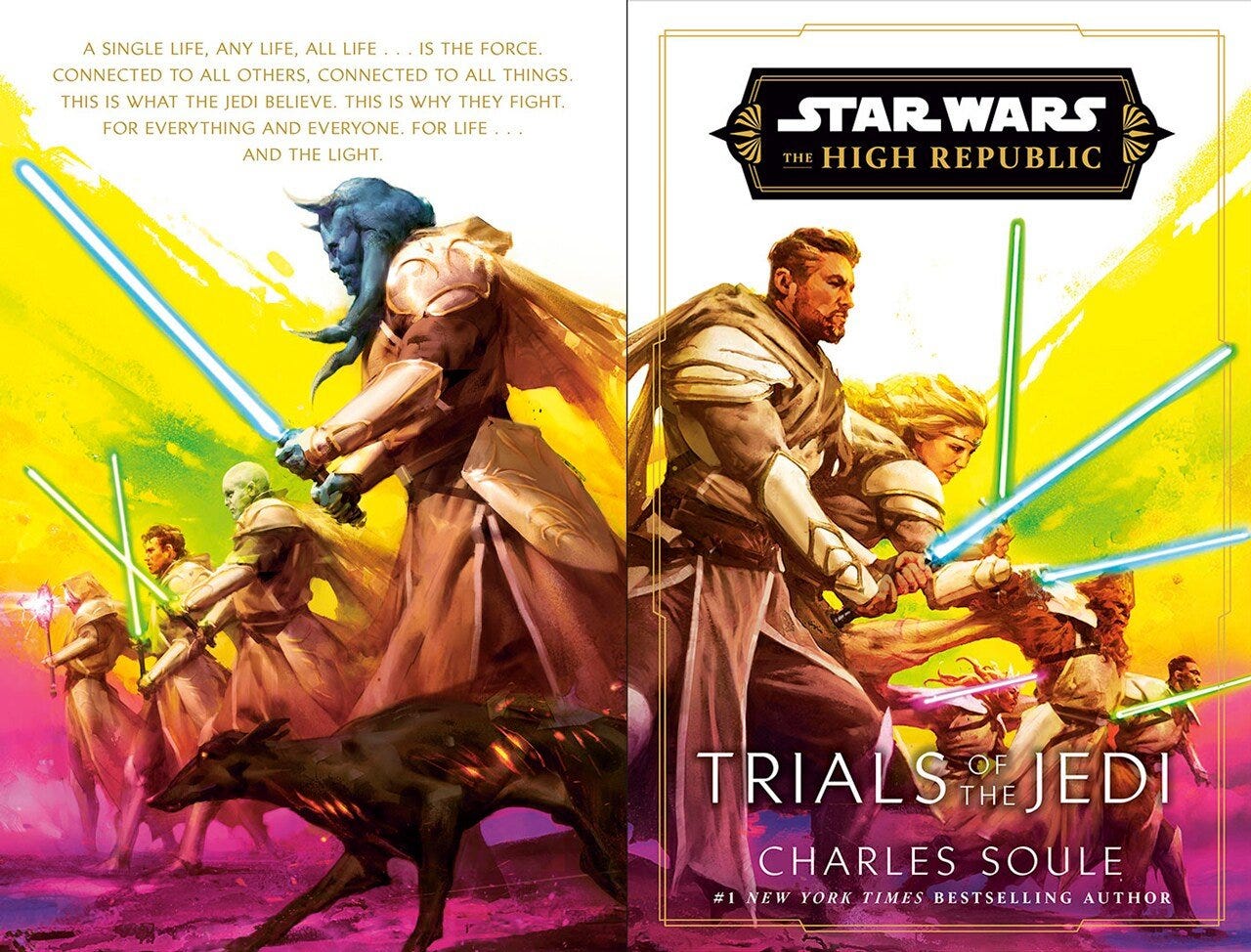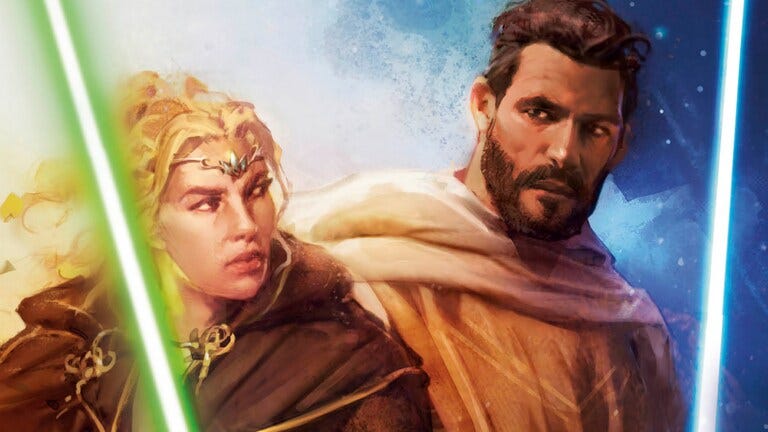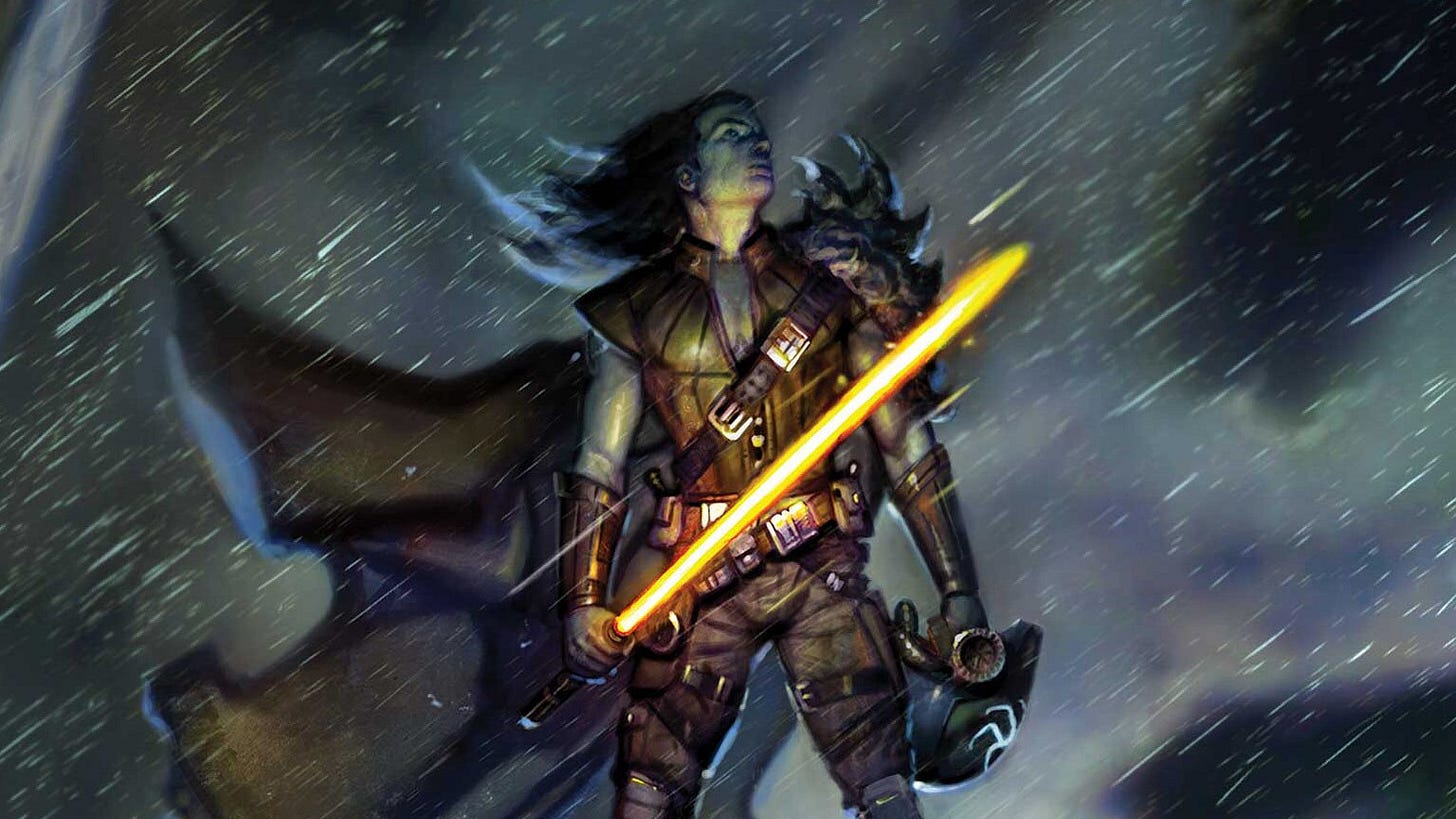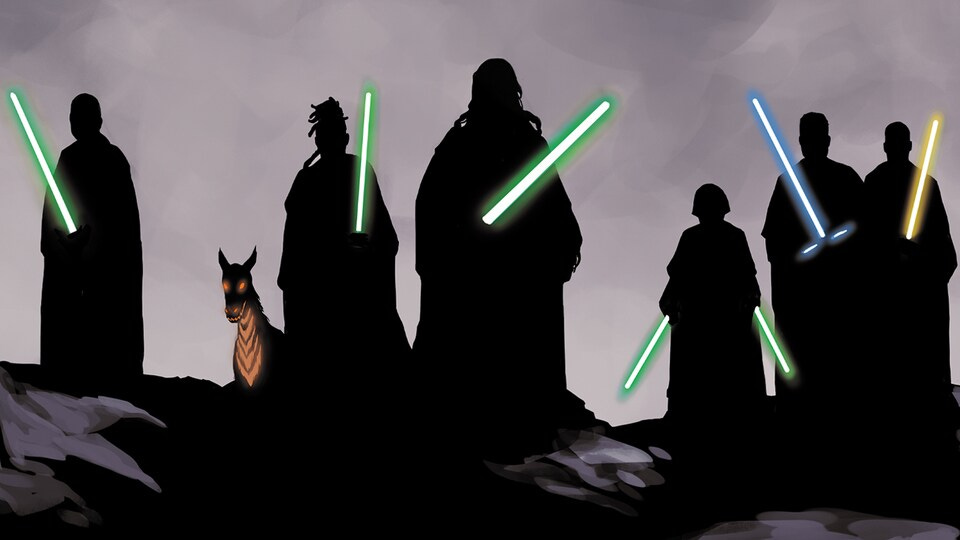"Trials of the Jedi" Review
The High Republic comes to a close with a high octane and bittersweet novel...
Note: The first third (or so) of this review is spoiler-free, while the remainder will delve into the specifics of the story. The change from spoiler-free to spoiler-full will be clearly marked.
Back at San Diego Comic-Con 2023, I interviewed several of the authors behind the ambitious High Republic publishing initiative. Phase III was just beginning, and a lot of hoopla was being made about how we were at the beginning of the end. So, naturally, I asked the writers how it felt to have the end in sight for this project that they had first conceived in Fall 2018.
“[The end] does not feel particularly close to me because I still have a whole book to write,” replied Charles Soule. “If anything, the start of writing that book is feeling like it’s looming, so it’s all very nerve-wracking.”
This week, almost two years later, that book Soule was referring to is here. Star Wars: Trials of the Jedi hit shelves on Tuesday, bringing The High Republic publishing initiative to a close. Yes, a handful of comic books are still to come, but the main story is now complete.
It was a herculean task for Soule, hence his nerves back in 2023, concluding a story that had been told across eight adult novels, eight YA novels, eight middle grade novels, 159 comic books, six manga volumes, thirty-two short stories, and three audio dramas. That’s 192 stories total, not to mention tie-ins with other Star Wars material, like The Acolyte and Tales of Galaxy’s Edge. It’s a lot of material to build on and plotlines to wrap up before you even consider pleasing the legions of ravenous fans the series has inspired over the past four years.
After finishing Trials of the Jedi this week, I can safely say he nailed it.
The novel is a thrill to read from start to finish. It manages to give enough time and space to each of its characters to wrap up their storylines, while still maintaining a sense of urgency as it races towards its conclusion. Every character gets an ending that feels true to their arc across the series, and no one is cheated out of a satisfying finish in favour of someone else or the need to wrap up the main plot.
Granted, all novels should do this, but what makes this one so impressive is its Avengers: Infinity War-level crossover of characters from various “sub-series.”
Because The High Republic is a multi-media project, characters were usually fleshed out in one specific medium (or “sub-series”). For instance, Elzar Mann primarily appeared in adult novels, Reath Silas was usually the star in YA novels, and Ty Yorrick mainly featured in YA comic books. There was plenty of crossover, and certain characters, like Avar Kriss and Marchion Ro, were regulars across the different media. But you could usually link a character to a specific set of stories where they were most frequently featured.
Trials of the Jedi eschews these artificial lines, bringing in characters from all the various stories (and age demographics) into one story. Just looking at the front and back covers, you can see the entire High Republic is well represented in the story. It gives the book a sense of scope that cements its place as the ending for the entire High Republic story, not just one of its “sub-series.”
Previous phases of The High Republic have stretched their conclusions across multiple media, and I was relieved to see they (mostly) didn’t do that here. A criticism I’ve had of the first two phases was that when they tried to tell different parts of the same climactic event in different stories, it often became muddled and left me feeling as though the story was incomplete. Both the fall of Starlight Beacon (Phase I) and the battle of Dalna (Phase II) suffered because the momentum was broken up by the time between instalments. Yes, The High Republic is a multi-media story, but it worked best when it was a series of separate stories that built on what came before.
Fortunately, Trials of the Jedi does just that. Within its pages, you get a complete picture of how the Nihil crisis ends. Though the Jedi mission to Planet X and the battle of Eriadu are only tangentially related, each is given its due in the novel in a way that builds off its characters’ experiences in the previous stories. Plus, if you want more, the events on Eriadu are further fleshed out in both the Fear of the Jedi and High Republic Adventures (2023) comic books in a way that (mostly) stands on their own. To me, that’s a win-win-win scenario.
It’s hard to say much more about the novel without delving into spoilers, so we’ll make that transition in just a moment. But first, let me say, if you have been waiting to check out The High Republic but didn’t want to get invested in it in case it either (a) didn’t get finished, or (b) didn’t have a good ending, then fear not! Trials of the Jedi is an amazing ending to the series, one that is both beautiful and bittersweet. And, like the best Star Wars, it has something to say—about our beliefs, our institutions, sacrifice, love, and second chances. It expands the Star Wars galaxy in enriching ways, with new characters, worlds, and perspectives.
The High Republic has reset the bar when it comes to Star Wars publishing. The whole series is a statement about what Star Wars storytelling can be when it’s ambitious and excellent, with Trials of the Jedi as the ultimate exclamation mark.
And now, let’s get to the spoilers. If you don’t want to know what happens in Trials of the Jedi, don’t scroll past the clip from The Simpsons embedded below.
SPOILER ALERT!
Let’s start with the big one: Avar and Elzar’s fate is so beautifully tragic.
Throughout Phase III, as the two characters finally gave in to their desires and became romantically linked, it was clear that it was never going to last. The Jedi Order is famously unchill about these sorts of things, and even though everyone seemed to be willing to look the other way when it came to these two for the time being, it was a question of how, not if, they would be kept apart.
Something I think Soule did very well throughout Trials of the Jedi was managing to have it both ways when it came to tricky questions. Avar and Elzar weren’t forced to make a noble sacrifice and split up for the sake of the Order, nor were they ripped apart by one of their deaths. Instead, they get to both be together and apart at the same time, keeping the balance on Planet X long enough for the Nameless population to be reborn and restore balance to the galaxy at large.
Selfless love—true love—has always been at the core of Star Wars. Here, Avar and Elzar’s love gives them the strength to hold the galaxy together. A selfish love would have seen them run away and find somewhere to hide as the Blight consumed the galaxy, while they hold on to each other at the expense of everyone else. But that’s not Avar and Elzar’s style. Both understand that even though they are physically apart, they are a part of something bigger than themselves. They lift each other up, even as they sacrifice their idyllic life together. Their bond will sustain them.
They don’t get a “ride off into the sunset” happy ending; it is bittersweet what happens to them. But it’s a choice they make together, rather than experiencing the trauma of a forced breakup (or worse). From a certain point of view, they will be together forever and doing what they do best: saving people.
With all the action set on Planet X, the long-lost world of the Nameless creatures, I found myself thinking of Mortis from The Clone Wars several times. Specifically, when the Father tells Anakin, Obi-Wan, and Ahsoka, “As the balance on this world crumbles, so too shall war escalate in your galaxy.”
Planet X, or Sophros as we learn its true name to be, is another version of exactly that. It’s deeply steeped in the Force, and what happens there has a massive impact on the larger galaxy. For every Nameless—or, Shrikarai, as we learn they’re called—that dies, an egg is produced to repopulate the species, but Marchion Ro’s actions have led to an imbalance which causes the Blight.
It’s a great reveal. It manages to show just how evil and depraved Ro’s actions are, while not totally absolving the Jedi of blame (they do kill Nameless after all, even if it is in self-defence), and gives the Shrikarai some agency in the story.
It’s also exciting that Lucasfilm is showing a willingness to explore more fantastical and mystical worlds and realms like Mortis or Sophros. As the Star Wars galaxy expands with every story, it’s good to see that these sorts of worlds are open to storytellers other than just Dave Filoni. They shouldn’t become regular occurrences, but from time to time, it’s good to delve into the weirder aspects of the Force.
(To be clear, I’m not taking a shot at Filoni here, I can’t wait to see what he does with Mortis in Ahsoka season two!)
Speaking of Marchion Ro, the conclusion to his story was another aspect of the larger High Republic story that Trials of the Jedi absolutely stuck the landing on! Defeating the big bad guy in a long-running story is another one of those challenges that not everyone can get right, but Soule managed to nail both Ro’s actual defeat and the aftermath of it.
Throughout The High Republic, our impression of Ro has gone through an evolution. In the early books, he felt like something of a charlatan. Then, as he started to win, we saw him as a tyrant. In Trials of the Jedi, we finally see him for what he truly is: a madman.
In hindsight, having Bell Zeitfar be the one to finally best Marchion Ro makes perfect sense. Ro's kidnapping, torturing, and then killing Bell’s master Loden Greatstorm loomed over much of Phase I (and Phase III). Bell’s feelings of guilt, as well as his simmering desire for vengeance, were key to his story arc across both phases. So when he finally comes face-to-face with his master’s killer, there is a real question of what he would do. Ultimately, he leans on Loden’s teachings to defeat, but not kill Ro. It was a conclusion to an arc that felt both satisfying and earned.
Keeping Ro alive, however, did present a new question for the denouement of the novel: what should justice look like for a monster like Ro? Usually, Star Wars has resorted to killing its villains off, allowing them to face cosmic justice rather than any sort of tangible justice in the realm of the living. Fortunately, this was another place where Soule bucked tradition.
Ro being sentenced to, essentially, life in solitary confinement is an interesting choice. It keeps him from ever hurting anyone (other than droids) ever again, but, just like solitary confinement in the real world, there is an inherent cruelty to it as well. In the final paragraphs of Ro’s story, I couldn’t help but feel a pang of sympathy for the dying warlord. This is not to say that the Republic did the wrong thing or should have given him the death penalty, just that there are no simple solutions when it comes to the aftermath of war.
My one criticism of Ro’s story is that I expected the ghosts of his ancestors to factor more into the story. It felt like him being able to see them lurking in the background, taunting him, was going to amount to something more. Especially since Marda Ro, one of the main characters of Phase II and the founder of the Nihil, was among them. Instead, they barely factored into the story. I can’t help but wonder if more was initially planned for that, but was cut because it ultimately didn’t fit the story. Regardless, it felt like a loose end (and not in a good way).
Another of the key relationships that played a major role in the story was Reath Silas and Azlin Rell. The ancient dark sider and the young historian’s dynamic has been central to the latter stories in Phase III. Reath has always recognized both the value and the danger in listening to Azlin, with the question looming of whether he could truly trust the old fallen Jedi.
Again, Soule does an excellent job of having it both ways when it comes to trusting Azlin. Reath and Azlin, along with Ty Yorrick, work together to utilize the Rod of Ages to free the Shrikarai from Ro’s influence. As a unit, they do the right thing, which gives Reath the confidence to let Azlin go his own way (despite Ty’s concerns).
Interestingly, Ty’s presence almost suggests that Reath is making the right decisions. She is living proof that someone can leave the Jedi, shed their dogmatic views and still do good in the galaxy. But she is far more skeptical than Reath of Azlin’s trustworthiness. As she points out, she hunts monsters, so she recognizes one when she sees one. And, to her, Azlin is a monster.
She is, of course, right. Despite being free of the fear of the Nameless, Azlin has spent too much time steeped in the Dark Side. Its call is too strong, and he chooses to embrace it. Reath wanted to believe that Azlin could be redeemed, that if the Nameless could be defeated, then he would get over his past trauma and return to the path of the Jedi. This has been something Reath has struggled with throughout the series; he always wants to see the good in people. It got him in trouble with Nan all the way back in Into the Dark, and it looks like it’s going to bite him in the ass again when it comes to Azlin. It’s not a bad thing to want to see the best in people, but it makes him an easy mark for those who use deception as their weapon.
Their final scenes, with Azlin bleeding the crystal in an old lightsaber and Reath dwelling on whether he made the right choice, are an example of a good loose end. It leaves open the door for more stories with these characters, even after the main series is done. When Michael Siglain, the architect behind The High Republic at Lucasfilm Publishing, teased that this wasn’t the last we would see of these characters, I hope he meant that a continuation of this story is in the works.
Those are the main storylines I wanted to touch on, but I’ll quickly run through some of the others. I enjoyed the parts of the book dedicated to Burryaga and Terec. Both were mainly relegated to supporting roles, but still made meaningful contributions to the story. And the limited time we did spend with them did a nice job of paying off their storylines from across the various High Republic stories.
Same goes for Torban “Buckets of Blood” Buck, though he wound up being the sacrificial lamb on the mission to Sophros. Everyone was not going to make it out alive, and Torban was the one to fall in battle. Plus, his death served as a sort of meta warning to the audience: if the guy who is best known for being in the YA comics can die, then no one is safe.
I also enjoyed the final confrontation between Porter Engle and General Viess. This was a storyline in the larger High Republic story that I can’t say I was all that invested in, but Trials did a nice job of wrapping it up, so I was pleased with that. It was the standout plotline in the Eriadu portion of the novel (which, while strong and necessary, was definitely the B-plot).
On the political front, I thought it was interesting that Ghirra Starros essentially got away with treason. She always showed herself to be a shrewd political operator, so in that sense it’s not really a surprise. Plus, it underscores the corruption that already exists in the Republic, which we all know will be its undoing. As for her hiring a private investigator to look for her daughter, Avon, only for them to find that she’s dead…well, I’m hoping this is another loose end that will be picked up on soon.
As for Lina Soh, I was a little surprised that she didn’t play a larger role in the story, though it’s hard to see where she could have factored more into the action. I did like her concluding that the Republic had to become less reliant on the Jedi. It’s both accurate (since we know the Jedi are not infallible) and sets the stage nicely for the tension between the Jedi and the Senate that we see in The Acolyte.
As I said above, Trials of the Jedi is a great novel and a great ending. It goes out of its way to be unexpected, but never feels like it’s sacrificing story for shock value. Soule took on the immense challenge of wrapping up this massive story and didn’t just meet expectations, he surpassed them. The High Republic as a whole is an incredible accomplishment, and Trials of the Jedi is its crowning jewel.









Saving this post for later once I’ve finished the book. I hope that Disney/Lucasfilm has seen how successful this era has been and continues to grow their universe instead of being so insular and focusing on the same eras (prequel and original mainly). Even if I haven’t loved an individual story (rarely) it still has been an incredible adventure to go on.